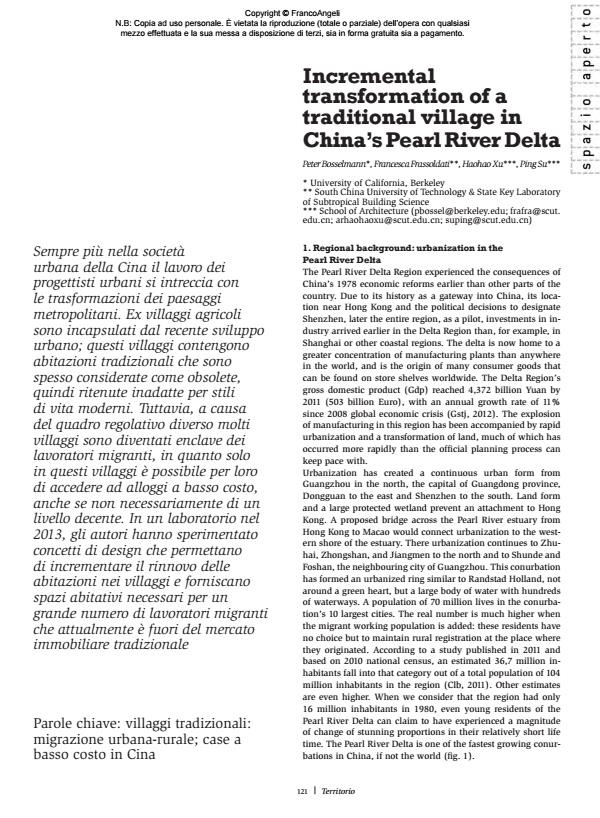Incremental transformation of a traditional village in China’s Pearl River Delta
Titolo Rivista TERRITORIO
Autori/Curatori Peter Bosselmann, Francesca Frassoldati, Haohao Xu, Ping Su
Anno di pubblicazione 2015 Fascicolo 2014/71
Lingua Inglese Numero pagine 9 P. 121-129 Dimensione file 885 KB
DOI 10.3280/TR2014-071019
Il DOI è il codice a barre della proprietà intellettuale: per saperne di più
clicca qui
Qui sotto puoi vedere in anteprima la prima pagina di questo articolo.
Se questo articolo ti interessa, lo puoi acquistare (e scaricare in formato pdf) seguendo le facili indicazioni per acquistare il download credit. Acquista Download Credits per scaricare questo Articolo in formato PDF

FrancoAngeli è membro della Publishers International Linking Association, Inc (PILA)associazione indipendente e non profit per facilitare (attraverso i servizi tecnologici implementati da CrossRef.org) l’accesso degli studiosi ai contenuti digitali nelle pubblicazioni professionali e scientifiche
Sempre più nella società urbana della Cina il lavoro dei progettisti urbani si intreccia con le trasformazioni dei paesaggi metropolitani. Ex villaggi agricoli sono incapsulati dal recente sviluppo urbano; questi villaggi contengono abitazioni tradizionali che sono spesso considerate come obsolete, quindi ritenute inadatte per stili di vita moderni. Tuttavia, a causa del quadro regolativo diverso molti villaggi sono diventati enclave dei lavoratori migranti, in quanto solo in questi villaggi è possibile per loro di accedere ad alloggi a basso costo, anche se non necessariamente di un livello decente. In un laboratorio nel 2013, gli autori hanno sperimentato concetti di design che permettano di incrementare il rinnovo delle abitazioni nei villaggi e forniscano spazi abitativi necessari per un grande numero di lavoratori migranti che attualmente è fuori del mercato immobiliare tradizionale
Parole chiave:Villaggi tradizionali: migrazione urbana-rurale; case a basso costo in Cina
- Reframing China’s heritage conservation discourse. Learning by testing civic engagement tools in a historic rural village Giulio Verdini, Francesca Frassoldati, Christian Nolf, in International Journal of Heritage Studies /2017 pp.317
DOI: 10.1080/13527258.2016.1269358
Peter Bosselmann, Francesca Frassoldati, Haohao Xu, Ping Su, Incremental transformation of a traditional village in China’s Pearl River Delta in "TERRITORIO" 71/2014, pp 121-129, DOI: 10.3280/TR2014-071019